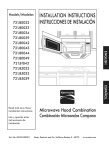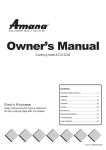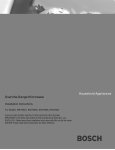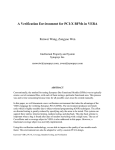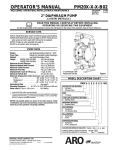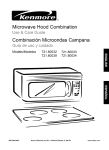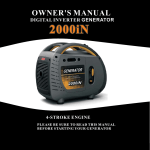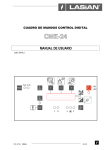Download Sears 721.80043 Owner`s manual
Transcript
Models/Modelos
721.80032
721.80033
721.80034
721.80039
721.80042
721.80043
721.80044
721.80049
INSTALLATION
INSTRUCTIONS
INSTRUCCIONES
DEINSTALACION
_.
I
_
_>
_
I
_
J
_J
Read and save these
installation instructions.
Lea y guarde estas
instrucciones de
instalaci6n
Part No. MFL39433001
MicrowaveHood Combination
Combinaci6n
Microondas
Campana
Sears, Roebuck and Co., Hoffman Estates, IL 60179
www.sears.com.
YOUR SAFETY FIRST
BEFORE
• Proper
YOU START
installation
is the installer's
responsibility!
- Read the entire manual before you begin.
- The model number label is located on the oven front. See Figure 1.
- Mounting plate is located on back side of microwave oven. See Figure 2.
BE SURE TO READ THE FOLLOWING
Model
Number
SAFETY
Label
INSTRUCTIONS:
Mounting Plate
t
Back of oven
Figure 1
Figure 2
WARNING
FOR YOUR
SAFETY:
• You will need TWO people to install this oven. It is heaw and could cause personal injury if not handled
properly. The dimensions of the oven are as follows:
• AVOID
Height
Width
: 16-7/16 inches
: 29-15/16 inches
Depth
Weight
: 15-11/16 inches
: 51.8 pounds
ELECTRICAL
SHOCK!
- Before you drill into the wall, note where electrical outlets are and where electrical wires might be
concealed behind the wall.
YOU COULD GET AN ELECTRIC SHOCK it you contact electrical wires with your drill bit.
- Locate and disconnect the power of any electrical circuits that could be affected by installing this oven.
IF YOU DO NOT DISCONNECT THE POWER, YOU COULD GET AN ELECTRIC SHOCK.
• ELECTRICAL
RATING
OF THIS OVEN
14 Amps / 1500 Watts(Microwave
: 120V, 60Hz.
oven + Cooktop Lamp + Ventilation Fan)
- You need a 120V, 60Hz, AC only, 15A or 20A, fused electrical supply (located in the cabinet above the
microwave as close as possible to the microwave circuit) serving only the microwave.
YOUR SAFETY FIRST
• THIS APPLIANCE
MUST
BE GROUNDED!
- If there is an electrical short circuit, grounding reduces the risk of electrical shock by providing an escape
wire for the electric current. This appliance is equipped with a cord having a grounding wire with a
grounding plug.
PROPERLY POLARIZED AND
GROUNDED
• Place the plug into a properly installed and grounded
outlet. See Figure 3.
• Do not use an extension cord.
• Keep the power cord dry and do net pinch or crush it.
OUTLET
• DO NOT, UNDER ANY CIRCUMSTANCES, REMOVE
THE POWER SUPPLY CORD GROUNDING PRONG!
This appliance MUST be grounded!
Three-Pronged
(Grounding) plug
Figure 3
_k WARNING
_k
If you use the grounding plug improperly, you risk electric shock!
- Check with a qualified electrician if you are not sure whether the oven is properly grounded or if you do
not completely understand the grounding instructions.
DO NOT USE A FUSE IN THE NEUTRAL OR GROUNDING CIRCUIT.
_k WARNING
Improper
grounding
could result in electric shock or other personal
SAVE THESE INSTRUCTIONS
• DO NOT
EXPOSE
_k
FOR THE LOCAL ELECTRICAL INSPECTOR'S
YOURSELF
TO EXCESSIVE
MICROWAVE
injury.
USE.
ENERGY!
-
DO NOT try to operate the microwave oven with the door open.
DO NOT tamper with or defeat the safety interlocks.
DO NOT place objects between the microwave oven front face and the door.
DO NOT allow soil or cleaner residue to build up on the flat surfaces around the microwave oven door.
DO NOT operate the microwave oven if it is damaged.
The microwave oven door must close properly to operate safely.
DO NOT use the microwave oven:
• If the door is bent.
• If the hinges or latches are broken or loose.
• If the door seals, sealing surfaces or glass is broken.
- DO NOT attempt to adjust or repair the oven yourself!
It should be adjusted and repaired by a qualified technician who can check for microwave leakage after
repairing the oven.
_k WARNING
If you do not use the microwave
to excessive microwave energy.
_k
oven as instructed,
you could be exposed
YOUR SAFETY FIRST
• MAKE
SURE YOU HAVE
ENOUGH
SPACE
AND SUPPORT.
- Mount the oven against a flat, vertical wall, so that it is supported by the wall. The wall should be
constructed of minimum 2" x 4" wood studding and 3/8" thick drywall or plaster/lath.
- ATTACH AT LEAST ONE of the two lag screws supporting the oven to a vertical, 2" x 4" wall stud.
- DO NOT mount the microwave oven to an island or peninsula cabinet.
- BE SURE the upper cabinet and rear wall structures are able to support 150 Ibs., plus the weight of any
items you place inside the oven or upper cabinet.
- Locate the oven away from strong draft areas, such as windows, doors, and strong heating vents.
- BE SURE you have enough space. See Figure 4 below for minimum vertical and horizontal clearance.
WARNING
If you do not mount the oven as instructed,
you risk personal
injury and/or
property damage.
i,_-
/Grounded
Plug
(inside upper cabinet)
Q
30" min. cabinet opening width
Power Supply
Cord Hole
30" min. clearance from bottom
of cabinet to cooking surface
or countertop
(Use templates included
with installation
instructions)
I
Figure 4
CAUTION
• Before you begin installing the oven, PLACE A PIECE OF THE CARTON OR OTHER HEAVY MATERIAL
(a blanket) over the countertop or cooktop to protect it. Do not use a plastic cover.
Failure to protect these surfaces could result inproperty damage.
THE
FOLLOWING
PARTS
ARE
SUPPLIED
WITH
THE
OVEN:
NOTE: Depending on your ventilation requirements, you may not use all of these parts.
Damper/duct connector
(for roof vented or wall vented installation)
Not Actual Size
One power cord clamp bushing
Four 1/4" x 2" lag screws
(for wall stud holes)
- Actual Size
One power cord clamp and
One dark-colored mounting screw
(to hold the power cord)
Actual Size
- Actual Size (for the cord hole in a metal upper cabinet)
Four 1/4" x 3" toggle bolts - Actual Size
(for drywall holes)
C-Two 1/4" x 3" bolts - Actual Size
(for securing to the upper cabinet)
Two tapping screws - Actual Size
(for attaching the damper duct connector)
OR
One upper
Size
cabinet
template
- Not Actual
i
Four spring toggle heads - Actual Size
(for the toggle bolts)
One rear wall template-
Not Actual Size
_:_.
REARWALL TEMPLATE
NOTE: You need to install at least one lag screw into a 2" x 4" stud and four anchor bolts into the wall,
and the mounting area must meet the 150 Ibs. weight requirement.
PARTS, TOOLS, MATERIALS
YOU WILL NEED THE FOLLOWING
INSTALLATION:
TOOLS AND MATERIALS
FOR THE
Carton or other heavy material for covering the counter top.
Clear tape
(for taping the templates to the wall)
Stud finder or thin nail.
Saber saw (for cutting vent holes for roof
or wall venting)
Key hole saw (for the power cord hole)
ill
Phillips screwdriver
(for the screws)
3/8" and 3/4" wood drill bits
1/2" and 3/16"
drill bits
Pencil
Flat blade screwdriver
,_
(for the bolts)
Plumb line
Measuring tape (metal preferred)
Duct Tape
Small side cutters or tin snips
Caulking gun
• If you have brick or masonry walls, you need special hardware and tools.
• The ductwork you need for the installation
damper.
is not included. All wall and roof caps must have a back-draft
STEP 1: PREPARE THE
ELECTRICAL CONNECTIONS
_k WARNING
AVOID ELECTRICAL
SHOCK!
_k
THIS APPLIANCE
MUST BE GROUNDED!
1. Locate the grounded electric outlet for this oven in the
cabinet above the oven, as shown in Figure 4 Detail.
Upper
I
NOTE: The outlet should be on a circuit dedicated to the
microwave oven 120V, 60Hz., AC only, with a
20ampere fused electrical supply.
Cabinet
-Grounded
IMPORTANT: If you do not have the proper wall outlet,
you MUST have one installed by a qualified
electrician.
Outlet
T
Q
2. You will cut the power-supply-cord hole (shown in
Figure 4 Detail) later when you prepare the wall and
upper cabinet in Step 4.
Power-Supply-Cord Hole
Figure 4 Detail
NOTE: Do not use an extension cord.
Keep the power cord dry and do not pinch or crush it.
_k WARNING
Improper
grounding
could result in electric shock or other personal
• DO NOT, UNDER ANY CIRCUMSTANCES,
CORD GROUNDING
PRONG!
• This appliance
_k
MUST be grounded!
REMOVE
THE POWER
injury.
SUPPLY
STEP 2:
PREPARE THE VENTING SYSTEM
NOTE: The ductwork you need for outside ventilation is not included with your oven. The standard ductwork
fittings and length are shown in Figure 9, page 9.
WARNING
THIS OVEN MUST BE PROPERLY
- FIRE HAZARD
1
VENTED!
You may vent your oven in one of three ways:
Roof Venting
If your oven is located on an outside wall near the roof, as in Figure 6 (3-1/4" x 10" duct) and
Figure 8 (6" round duct.)
Wall Venting
If your oven is located on an outside wall on the first floor of your house, as in
Figure 5 (3-1/4" x 10" duct) and Figure 8 (6" round duct.)
Room Venting
If your oven is located on an inside wall of your house, as in Figure 7.
NOTE: If you choose the rear exhaust method (roof or wall venting), be sure there is enough clearance within the
wall for the exhaust duct.
Wall Venting
Roof Venting
roof cap \
cabinet
cabinet
3-1/4"x10"
duct
wall cap
/1
Wall venting
3-1/4"x10" through-the-wall
duct
oven
through-the-roof
Roof venting
Figure 5
REMEMBER
Figure
6
AS YOU INSTALL THE VENTING:
• Keep the length of the ductwork and the
number of elbows to a minimum to
ventilate your oven efficiently.
See examples on page 9.
• Keep the size of the ductwork the same.
Room Venting
6" min.
diameter
round duct
cabine_
• Do not install two elbows together.
• Use duct tape to seal all joints in the duct
system.
• Use caulking to seal the exterior wall or
roof opening around the cap.
roof cap
wall cap
elbow
ove:
Figure 7
3-1/4"to round
duct transition
_J
3-1/4"to round
ductwork
transition
Figure 8
STEP 2:
PREPARE THE VENTING SYSTEM
STANDARD
FITTINGS
NOTE: If the existing duct is round, you must use a rectangular-to-round adapter, with a rectangular 3" extension
duct installed between the damper assembly and the adapter to prevent the exhaust damper sticking.
DUCT LENGTH
The total length of the duct system, including straight duct, elbows, transitions, wall or roof caps must not
exceed the equivalent of 140 feet.
For best performance, do not use more than three 90 degree elbows.
Below are the standard fittings and their equivalent length in feet.
3-1/4"x10" to 6" = 5ft.
3-1/4"x10"
90 ° elbow = 1Oft.
3-1/4"x10" 90 ° elbow = 25ft.
roof cap = 24ft.
45 ° elbow = 5ft.
3-1/4"x10" wall cap
= 40ft.
3-1/4"x10" fiat elbow
= 1Oft.
Figure 9
To calculate the equivalent length of each duct piece used, see the examples below.
Exam
For 3-1/4"x10"
3-1/4"x10"
90 ° elbow
_
)les
SYSTEMS
For 6" ROUND
6ft. _
*_fr_
wall cap
90° elbows
_---
SYSTEMS
6ft. -_/wall
cap
I 0_"
transi_
1 3-1/4" x 10" 90° elbow
=
25ft.
1 transition
2 90 ° elbows
=
=
5 ft.
20 ft.
1 wall cap
8 feet straight duct
TOTAL LENGTH
=
=
=
40 ft.
8 ft.
73 ft.
1 wall cap
8 feet straight
TOTAL LENGTH
=
=
=
40 ft.
8 ft.
73 ft.
STEP 3:
PREPARE THE VENTING BLOWER
Your microwave oven is shipped with the blower assembled for room venting (recirculating).
the blower if you want wall vented or roof vented installation.
You need to adjust
WARNING
ELECTRICAL
SHOCK
HAZARD!
UNPLUG
UNIT BEFORE
WORKING
ON IT.
DO NOT PULL OR STRETCH THE BLOWER WIRING! Pulling and stretching the blower wiring could result
in electrical shock.
1. Remove any shipping materials and parts from inside
the microwave oven.
A thick protective
covering
/
2. Cover the counter top or cooktop with a thick,
protective covering to protect it from damage and dirt.
See Figure 10.
NOTE: If you have a free-standing range, disconnect
it, move it onto a piece of cardboard or
hardboard and pull it away from the wall, so
that you can get closer to the upper cabinet
and back wall for easier measuring and
drilling.
Figure 10
3. Remove mounting plate 2 screws from the mounting
plate as shown and discard them.
(See Figure 11.)
I
Mounting plate
4. The mounting plate will also be used to locate and
mark the mounting holes on the rear wall.
5. Locate exhaust adaptor, grease filters and hardware
packet.
6. At this point, remove any adhesive tape (if there is
any), on the exhaust adaptor, the grease filters and
the power supply cord.
Mounting plate
screw
(2 screws)
f
--
ROOM VENTED
INSTALLATION:
Go to STEP 4, PREPARE THE WALL AND UPPER
CABINET FOR INSTALLATION located on page 13.
10
Control Panel Side
Figure 11
STEP 3:
PREPARE THE VENTING BLOWER
WALL VENTED
INSTALLATION:
1. Remove one blower unit mounting screw and
two blower plate screws. Remove the blower
plate from cabinet. See Figure 12.
_back
blower unit
blower plate
mounting screws
2. Carefully lift the blower unit out of the microwave
oven. Disconnect the blower wire from
connector. See Figure 13.
3. Use side cutters or tin snips to cut and remove
knockouts "B" from Back plate. Discard
knockouts. Be careful not to distort the plate.
See Figure 14.
4. Rotate the unit so that the exhaust ports face the
rear of the cabinet. See Figure 15. Before you
insert blower unit, blower wire must be like
Figure 15.
plate
Knockouts "B"
"%L.
blower unit
mounting screw
blower plate
Figure
12
5. Reassemble the blower wire into the connector.
.blower wire
6. Place blower unit back into cabinet. Check that
the exhaust ports face towards the rear of the
cabinet. See Figure 16.
7. Reattach the blower plate to the top of the
cabinet as it was originally assembled. Attach
with one blower unit mounting screw and then
two blower plate mounting screws.
See Figure 17.
connector
Figure 13
8. Go to STEP 4, PREPARE THE WALL AND
UPPER CABINET FOR INSTALLATION
located on page 13.
Knockouts
blower
unit
Parts "B"
exhaust
ports
Figure 14
Figure 15
blower plate
mounting
screws
Y
blower unit _.,_.._._%_
exhaust ports
exhaust
ports
Figure 16
blower unit
mounting screw
Figure 17
11
STEP 3:
PREPARE THE VENTING BLOWER
ROOF VENTED
INSTALLATION:
blower plate
mounting
screws
1. Remove one blower unit mounting screw and
two blower plate screws. Remove the blower
plate from cabinet. See Figure 18.
2. Carefully lift the blower unit out of the
microwave oven.
blower plate
blower unit
mounting screw
3. Rotate blower unit 90 ° so the exhaust ports
face the top of the cabinet. See Figure 19.
Figure
18
4. Place blower unit back into microwave oven.
5. Use side cutters or tin snips to cut and remove
knockouts "A" from blower plate. Discard
knockouts. Be careful not to distort the plate.
See Figure 20.
blower
unit
Figure 19
6. Reattach blower plate to microwave oven.
Knockouts "A"
Attach with the one blower unit mounting
screw and then the two blower plate mounting
screws. See Figure 21.
/
blower plate
Figure 20
blower unit
blower plate
mounting
screws
blower plate
blower unit
mounting screws
Figure 21
12
STEP 4: PREPARE THE WALL AND
UPPER CABINET FOR INSTALLATION
MEASURE AND TACK / TAPE UP THE
TEMPLATE
1. Using a plumb line and (metal) measuring tape, find
and mark the vertical center line (_)on the back
wall, as in Figure 22.
2. Find and mark one or two points where the studs
are on the wall (Studs are normally 16 inches apart.)
and then measure and mark the stud locations. If
--
i
you cannot find any wall stud, consult a local
building contractor.
I
I
i
CAUTION
m
DO NOT ATTEMPT TO INSTALL THE
MICROWAVE OVEN IF YOU CANNOT FIND A
WALL STUD.
Figure 22
3. Line up the plumb line on the wall with the center
line on the mounting plate.
NOTE: Be sure the minimum width is 30 inches and
the distance from the top of the mounting
plate to the range or counter top is at least
30 inches. See Figure 4 on page 4.
4. Center mounting plate in opening by lining up the
plumb line on wall with centerline on mounting plate.
Make sure the minimum width is 30 inches and that
the top of the mounting plate is located a minimum
of 30 inches above the cooking surface.
See Figure 23.
NOTE: If the front edge of the cabinet is lower than
the back edge, adjust the mounting plate to
be level with the cabinet front.
upp_
o
c@bj99t temqlate
o°
_,....... j,
o
mounting
plate
(3 pieces mounting plate)
Figure 23
5. Measure the bottom of the upper cabinet frame.
Trim the edges "A", "B" and "C" on the upper
cabinet template so that the template will fit on the
bottom of the upper cabinet. If upper cabinet has a
recessed frame, trim template so that it fits inside
the recessed area. Align the centerline of the upper
cabinet template with the centerline of the mounting
plate; then securely tape or tack the upper cabinet
template in place. See Figure 23.
13
STEP 4: PREPARE THE WALL AND
UPPER CABINET FOR INSTALLATION
DRILL THE HOLES IN THE WALL AND UPPER CABINET.
WARNING
BE VERY CAREFUL
WHEN DRILLING
HOLES
INTO THE WALL.
Electrical wires could be concealed behind the wall covering and if the drill hits them you
could get an electric shock.
1. Find the points on the mounting plate labeled "A", "B", "C" and "D". Drill a 3/16" diameter hole at any of
these points that are in front of a wall stud. Drill a 3/4" diameter hole at any of these points that are over
drywall.
2. Drill a 3/8" hole at points "J" and "K" on the upper cabinet template.
NOTE: If the bottom of the upper cabinet is recessed 3/4" or more, you will need 2"x2" filler blocks (not
included) to provide additional support for the bolts. See Figure 24.
• Mark the center of each filler block and drill a 3/8" diameter hole at the mark.
• Align filler blocks over the two openings in the top of the microwave oven cabinet and attach to cabinet with
masking tape. See Figure 25.
3. Cut or drill a 2" diameter hole at the area marked "M", "power supply cord hole" on the upper cabinet template.
If the upper cabinet is metal, you will need to cover the edge of the hole with the power supply cord bushing
(supplied) to prevent damage to the cord from the rough metal edge.
WARNING
cabinet front
YOU MUST COVER THE EDGE OF
THE POWER SUPPLY CORD HOLE
IN A METAL CABINET WITH THE
POWER SUPPLY CORD BUSHING.
FAILURE TO DO SO COULD
RESULT IN DAMAGE TO THE CORD
AND ELECTRIC SHOCK.
filler block
Figure 24
4. Cut out the venting areas (with the saber saw):
• Roof Venting: cut out the shaded area marked "L"
on the upper cabinet template.
• Wall or Room Venting (Recirculating): go to STEP
5, INSTALL THE MOUNTING PLATE, located on
page 15.
filler
block
5. Use caulking compound to seal the exterior wall or
roof opening around the wall cap or roof cap.
Figure 25
14
cabinet
bottom shelf
STEP 5: INSTALL THE MOUNTING
PLATE TO THE WALL
THE OVEN MUST BE CONNECTED
TO AT LEAST ONE WALL STUD.
1. Draw a vertical line on the wall at the center of the
30" wide space.
3/16" Hole on Studs
3/4" Hole on Dry wall Only
hFMoi
nimr?l_em66'or
1
I I I
For WallVented Only
h
Use the mounting plate as the template for the
rear wall. Place the mounting plate on the wall,
making sure that the tabs are against the bottom
of the cabinet. Line up the notch and center line
on the mounting plate to the center line on the
wall.
2. While holding the mounting plate with one hand,
draw circles on the wall at holes "A", "B", "C"
and "D". Four holes must be used for mounting. If
the holes are not used, the installation will not be
secure. Installer must use these holes for proper
installation. Use toggle bolts through these holes
unless one of them lines up with a stud. Use a
wood screw for studs. See Figure 26.
adaptor/mounting
|
4. Attach the plate to the wall. To use spring toggle
head bolts: Remove the toggle wings from the
bolts. Insert the bolts into the mounting plate and
replace the spring toggle heads to 3/4" past the
bolt ends. Insert the spring toggle heads into the
holes in the wall to mount the bracket. You may
pull forward on the bracket to help in tightening
the toggle bolts. Tighten all bolts. See Figure 27.
Mounting
Plate
/
(
/[_
_L
Center Line
l
[
[]
J
Support Tab
plate for wall vented.
3. Drill holes through the circles. If there is a stud,
drill a 3/16" hole for lag screws. Two or preferably
four lag screws at holes "A" and "C", or "B" and
"C" must be used to secure mounting plate to
wall. If there is no stud, drill a 3/4" hole for toggle
bolts. Make sure to use at least 1 lag screw at
holes of area "E" in a stud, and 4 toggle bolts at
holes "A", "B", "C" and "D" in the drywall or the
plaster.
t
i
t
t
t
/
/
NOTE: Draw a fifth circle inside area "E", through
one of the holes to match the location of a
stud.
For wall vented: The oven requires a rear wall
cutout opening for the rear wall duct and the
exhaust adaptor must be attached to the mounting
plate. See the next page on how to prepare the rear
wall cutout opening and the exhaust
m
I
)
Support Tab
(3 pieces
mounting
plate)
Figure 26
Mounting
I
i
Plate'....lY:
!J
Space More Than Watt Thickness
Toggle Wings
__
,(I t
,,, Toggle Bolt {k
Figure 27
15
STEP 5: INSTALL THE MOUNTING
PLATE TO THE WALL
TO PREPARE THE REAR WALL
CUTOUT OPENING AND EXHAUST
ADAPTOR/MOUNTING
PLATE FOR
WALL VENTING AND ROOF VENTING:
NOTE: If room vented installation is used, skip this
step.
1. Using the Wall-template.This template will give the
location and size of the box cutout for the rear wall
duct as described in step 5 item 1(page 15)
•
_': -
REAR
2. Using a pencil, put dots through slots "F" and "G",
and through holes "H" and 'T'. Remove the
mounting plate and draw lines extending through
the points. This will give the location and size of the
box cutout for the rear wall duct. See Figure 28.
WALLTEMPLATE
-
Figure 28
• Attach the exhaust adaptor to the rear mounting
plate by sliding it into the guides at the top center
of the plate on the wall side. Push in securely until
it is past the top locking tabs and in the lower
locking tabs. Take care to assure the damper
hinge is installed so that it is at the top and that the
damper swings freely.
Damper
(hinge side up)
Exhaust Adaptor
Plate
• Carefully guide the exhaust adaptor, now attached
to the mounting plate, into the house duct, before
using the screws to attach the plate to the wall.
This will assure proper alignment for installation.
See Figure 29.
Slide exhaust
(wall side)
adaptor into
guides on
rear panel.
Locking
Tabs
o
• Return to step 5, item 3 (page 15) to continue.
After completing the installation of the mounting
plate, again check the rear damper for free
movement to assure it will operate properly.
16
Figure 29
/
Guides
STEP 6:
A TTACH THE OVEN TO THE WALL
A WARNING
A
You will need two people to lift this
microwave. Failure to use more
o
than one person could result in
personal injury.
power cord
1. Carefully lift microwave oven and hang it on support
tabs (See Figure 26) at the bottom of the mounting
plate. Reaching through upper cabinet, thread
power supply cord through the power supply cord
hole in the bottom of the upper cabinet.
See Figure 30.
Fi _ul"e 30
2. Rotate the microwave oven upward so the top of
oven is against the bottom of the upper cabinet or
cabinet frame.
3. Then insert a bolt down through each hole in the
upper cabinet bottom. See Figure 31.
Tighten the bolts until the gap between the upper
cabinet and microwave oven is closed.
4. If wall vented or room vented installation is used, go
to No. 7 on the next page.
Figt_re
31
17
STEP 6:
ATTACH THE OVEN TO THE WALL
5. Roof vented installation: See Figure 32.
Install ductwork through the vent opening in the
upper cabinet. Complete the venting system through
the roof according to the method needed. See
"PREPARE THE VENTING SYSTEM," STEP 2 on
the page 8. Use caulking to seal exterior roof
opening around the exhaust cap. See Figure 6 on
page 8.
r
{,-Figure 32
6. Use power supply cord clamp to bundle the power
supply cord. Install the power supply cord clamp,
using a screw as shown in Figure 33, to inside of
the cabinet.
7. To install the grease filter: Slide it into the slide slot,
then push up and toward oven center to lock.
power
See Figure 34.
supply
cord "
clamp
8. Plug in the power supply cord.
{
9. Read your Owner's Manual, then check the
operation of your microwave oven.
{ ,--
Figure 33
Figure 34
18
MEMO
19
Printed in China




















